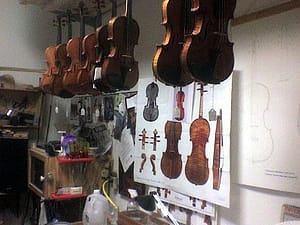 When you love both music and woodworking, what do you do when you want to slow down your career? The Doug Marples answer: Make violins!
When you love both music and woodworking, what do you do when you want to slow down your career? The Doug Marples answer: Make violins!
When Doug Marples decided it was time to leave his internal medical practice in Garden City in 2005, he enrolled in a school to learn the craft of making violins, violas and cellos. Now he spends his time creating instruments in his shop in west Lawrence.
The process of making a violin, viola, or cello is much the same, Marples explains, although obviously the scale of each type of instrument is different. The first concern in creating a fine instrument is to select high-quality wood and to let it dry and season.
Using the classic Cremonese Method, Marples traces the shape of an instrument that he wants to use as a template and makes a inside mold of walnut. Willow blocks are placed around the mold to which the ribs or sides of very thin maple are glued. A heating iron bends the maple into the curved shapes necessary.
The top and back of an instrument are made from a single piece of wood. Marples splits the wood block and uses a gouge to create the arch in the wood on both the top and the bottom plates. He then planes the wood to the opportune thickness. Inlay around the edge of the instrument is made of veneer. This purfling reinforces and increases the plates’ flexibility as well as adding visual beauty.
Next, the mold is removed, and the plates are glued to the ribs and blocks. F-holes are carved on either side of the top of the instrument. A sound post is positioned on the treble side of the instrument, and a bass bar supports the the lower strings. Creating the neck, fingerboard, and scroll for the instrument is another a carving job. Their alignment is important to the playability of the instrument. The mortise connects the neck to the body.
Once the instrument is made, Marples applies a gelatin-like sealer made of alum and protein. Then he applies a clear ground varnish of linseed oil and resins and often a colored varnish as well.
Marples says it takes about 4-5 weeks to carve a violin or viola and about twice that long to carve a cello. The varnishing process takes 2 to 3 months, no matter what type of instrument he is making.